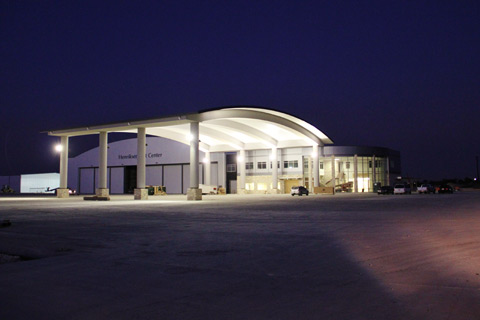
After more than a decade without a reliever airport, Austin now has Austin Executive Airport. The site has an arrival canopy for business aircraft, an expansive terminal, and hangars for G.A. aircraft.

Telecommunications entrepreneur and pilot Ron Henriksen saw potential in the small Bird's Nest Airport 12 miles northeast of Austin.

Austin Executive is the second airport Henriksen has built in Texas. Henriksen holds an air transport pilot certificate.

Henriksen expanded and reoriented the runway.

A pipeline that ran under the runway had to be lowered during airport construction. The resulting trench cut the existing runway to about 1,550 feet.

The flight office at Bird's Nest Airport was replaced with Austin Executive's 27,500-square-foot FBO terminal building.
Photos courtesy of Ron Henriksen.
More than a decade after the rapid closure of the area’s two main general aviation airports scattered them to the wind, Austin-area pilots are coming home.
Robert Mueller Field and Austin Executive Airpark closed within 60 days of each other in 1999, leaving the city without a reliever airport and hundreds of aircraft owners hunting for a nearby place to base their aircraft. With limited— and costly—options at the new Austin-Bergstrom International Airport, some pilots moved their aircraft 20 or 30 miles away. Now dozens of T-hangars and sunshades, a 6,025-foot runway, and a 27,500-square-foot FBO terminal building are enticing pilots to the new privately owned, public-use Austin Executive Airport, 12 miles northeast of Austin.
AOPA President Craig Fuller joined airport owner and developer Ron Henriksen for the grand opening June 8. The event drew about 400 people to the airport, which already has a steady stream of business and general aviation traffic.
Henriksen, a businessman and airline transport pilot with 6,500 hours and a flight engineer certificate, had already built Houston Executive Airport from scratch when he surveyed the 2,700-foot-long, 25-foot-wide airport runway of what was then Bird’s Nest Airport in 2007. He had met with a group of pilots who had an option to buy the airport and plans to expand it but not the capital to do so, and thought he might build his second airport.
The gravel and asphalt runway had been there for decades and was slowly being overtaken by weeds, he said: “It was hard to tell where the runway really was.” But he saw potential in the property. He knew that the area needed a reliever airport: AOPA and the local aviation community had been pushing for a new GA facility since the city shut down Robert Mueller Field. And Bird’s Nest was conveniently located just outside of Austin.
“The city needed another airport,” Henriksen said. “It really didn’t have a reliever. And so the question is, do you take an old airport that’s been there for 35 years and redo it, or do you try to build an airport from scratch?”
He decided to go with the existing airport, reasoning that expanding an airport would meet less opposition from the community than building a new one. Still, the process wasn’t easy: The existing north-south runway couldn’t be extended without running into a stream, so the new runway was rotated to an alignment of 13/31. There wasn’t enough power at the small facility to support an executive airport, so it had to be brought in from half a mile away. And workers laid at least a mile and a half of 16-inch water line to replace the two-inch line that had served the airport, Henriksen said.
“That was fine for the two toilets and the one sink that they had,” he said—but not for a terminal and sprinkler system in hangars.
Plus, the project hit an unexpected snag almost as soon as it started when the Lower Colorado River Authority made plans to build high-voltage power transmission towers off the end of the runway. The case went to court, and AOPA filed a petition with the administrative law judge to represent GA in the legal proceedings, providing legal briefs supporting the airport. The state Public Utility Commission ruled that the power lines must not interfere with runways at the airport.
AOPA Southwest Regional Representative Shelly deZevallos testified in favor of the airport. deZevallos and AOPA Vice President of Airport Advocacy Bill Dunn have been fighting for GA facilities in the Austin area for more than a decade. AOPA fought the closure of Robert Mueller Field, lobbied for the opening of a new facility, and pushed for reasonable GA access to Austin-Bergstrom International Airport. The association and aviation community rallied behind Henriksen’s efforts to fill the void left by Austin’s closure of Robert Mueller.
“Everybody as a community got behind it,” said deZevallos. She said AOPA, the National Business Aviation Association, and the Texas Aviation Association helped generate public support for the airport and raise awareness, and that the project moved forward with support from the Texas Department of Transportation and the FAA.
Once the new runway was in place, the transformed airport became Austin Executive Airport, complete with a new FAA identifier. The airport accommodates both business jets and smaller aircraft, and Henriksen said work is under way for a turf runway that will be aligned with the old Bird’s Nest runway. He said there are plans for even more facilities at the revitalized airport, and while the project was a big challenge, “I had fun doing it. It was a lot of fun.”


